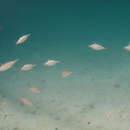Trophic Strategy
provided by Fishbase
Found on the continental shelf and continental slope (Ref. 75154). Lives in sandy or muddy places 20 to 150 m depth (Ref. 9137). Schooling species (Ref. 75154).
Morphology
provided by Fishbase
Dorsal spines (total): 6 - 8; Dorsal soft rays (total): 11 - 13; Analspines: 0; Analsoft rays: 18 - 20; Vertebrae: 24
- Recorder
- Cristina V. Garilao
Diagnostic Description
provided by Fishbase
Reddish pink in color, silvery below (Ref. 5382). Body compressed, without scales. Mouth is placed at the end of the long tubular snout (Ref. 35388). Snout length (6.1cm), length of second dorsal spine (LDS 3.9 cm) (Ref. 39875).
- Recorder
- Cristina V. Garilao
Biology
provided by Fishbase
Found between the seabed and midwater on the lower continental shelf, over sand. Juveniles found in oceanic surface waters (Ref. 2683); adults normally live close to the bottom (normally in 50-350 m depth (Ref. 47377)). Gregarious. Juveniles feed mainly on pelagic invertebrates, mainly copepods, while adults feed on bottom invertebrates (Ref. 6732). Seems to be sympatric with Macroramphosus gracilis (Lowe, 1839) all around the world (Ref. 89357).
- Recorder
- Christine Papasissi
Importance
provided by Fishbase
fisheries: commercial; aquarium: public aquariums
- Recorder
- Christine Papasissi
分布
provided by The Fish Database of Taiwan
廣泛分布於全世界各熱帶及亞熱帶海域。臺灣主要發現於東北部及西南部海域。
利用
provided by The Fish Database of Taiwan
小型魚類,常為拖網捕獲,除學術研究外,不具食用價值。
描述
provided by The Fish Database of Taiwan
體延長而稍側扁;體長約體高之4倍。頭中大;吻突出呈管狀,體高短於吻長。口位於管狀吻的頂端;無頜齒。體被粗雜小鱗;二列骨板僅見於頭部至背鰭間之背部,每一列包括3個發育完全之大骨板及1個小骨板。第一背鰭位於體中部後方,具III硬棘,其中第II硬棘特別強大而長;第二背鰭具11軟條;腹鰭小,無硬棘;臀鰭具18-20軟條;尾鰭叉形。體呈淡紅色或橘黃,腹部銀白。
棲地
provided by The Fish Database of Taiwan
主要棲息於砂泥底質海域,一般棲息深度在50-350公尺間,最深可達600公尺。在海底時常頭部向下,身體持傾斜姿勢,當游泳時則呈水平姿勢。以浮游生物及底棲無脊椎動物為食。
Longspine snipefish
provided by wikipedia EN

School of trumpetfishes (Macroramphosus scolopax), Faial-Pico Channel, Azores Islands, Portugal
The longspine snipefish, bellowfish, common bellowsfish, snipe-fish, snipefish, spine trumpet fish, or trumpetfish, Macroramphosus scolopax, is a snipefish of the genus Macroramphosus. It is also known as the slender snipefish off the South African coast.[3] [4]
Distribution
This fish is found worldwide in tropical to subtropical water[3] in the Atlantic, Indian, and west Pacific Oceans, at depths of 25 to 600 m (82 to 1,969 ft)ea. It has also been observed in the eastern Pacific off Santa Catalina Island, California.
Description
Longspine snipefish are reddish pink dorsally but have silvery bellies. They have a large eye, long snouts and a slender spine protruding dorsally.[3]
Ecology
The longspine snipefish feeds on crustacean zooplankton such as copepods and ostracods, as well as benthic invertebrates.[3]
In the month-long NORFANZ Expedition of 2003 which examined the biodiversity of the seamounts and slopes of the Norfolk Ridge, 5000 specimens averaging 78 g (2.8 oz) were collected from three locations.[5]
Reproduction
Courting males follow and swim parallel to the female near the bottom. The two fish join by their caudal peduncle, and the genital papilla of the female extends and contacts the genital region of the male repeatedly. Courting males change color and act aggressively with other males prior to this process. [4]
References
-
^ Fritzsche, R.; Matsuura, K.; Collette, B.; et al. (2010). "Macroramphosus scolopax". The IUCN Red List of Threatened Species. 2010: e.T155030A4705899. doi:10.2305/IUCN.UK.2010-4.RLTS.T155030A4705899.en.
-
^ Froese, Rainer; Pauly, Daniel (eds.) (2018). "Macroramphosus scolopax" in FishBase. February 2018 version.
-
^ a b c d Smith, M.M. and Heemstra, P.C. (eds.) 2003. Smiths' Sea Fishes ISBN 1-86872-890-0
-
^ a b De Oliveira, Rui Fil; Carvalho Almada, Vitor A.; De Fátima Gil, Maria Gil (1 April 1993). "The reproductive behavior of the longspine snipefish, Macrorhamphosus scolopax (Syngnathiformes, Macrorhamphosidae)". Environmental Biology of Fishes. 36 (4): 337–343. doi:10.1007/BF00012410.
-
^ NORFANZ Voyage Archived 2012-04-15 at the Wayback Machine Retrieved 2011-10-29.
- Tony Ayling & Geoffrey Cox, Collins Guide to the Sea Fishes of New Zealand, (William Collins Publishers Ltd., Auckland, New Zealand 1982) ISBN 0-00-216987-8

- license
- cc-by-sa-3.0
- copyright
- Wikipedia authors and editors
Longspine snipefish: Brief Summary
provided by wikipedia EN

School of trumpetfishes (Macroramphosus scolopax), Faial-Pico Channel, Azores Islands, Portugal
The longspine snipefish, bellowfish, common bellowsfish, snipe-fish, snipefish, spine trumpet fish, or trumpetfish, Macroramphosus scolopax, is a snipefish of the genus Macroramphosus. It is also known as the slender snipefish off the South African coast.
- license
- cc-by-sa-3.0
- copyright
- Wikipedia authors and editors
Description
provided by World Register of Marine Species
Found between the seabed and midwater on the lower continental shelf, over sand. Juveniles found in oceanic surface waters (Ref. 2683); adults normally live close to the bottom (normally in 50-150 m depth). Gregarious. Juveniles feed mainly on pelagic invertebrates, mainly copepods, while adults feed on bottom invertebrates (Ref. 6732).
Froese, R. & D. Pauly (Editors). (2023). FishBase. World Wide Web electronic publication. version (02/2023).
- license
- cc-by-4.0
- copyright
- WoRMS Editorial Board
Diet
provided by World Register of Marine Species
Juveniles feed mainly on copepods and adults prefer bottom invertebrates
North-West Atlantic Ocean species (NWARMS)
- license
- cc-by-4.0
- copyright
- WoRMS Editorial Board
Distribution
provided by World Register of Marine Species
Western Atlantic: 42.96°N and the Greater Antilles; also northern South America and Argentina
North-West Atlantic Ocean species (NWARMS)
- license
- cc-by-4.0
- copyright
- WoRMS Editorial Board
Habitat
provided by World Register of Marine Species
Found between the seabed and midwater on the lower continental shelf, over sand.
North-West Atlantic Ocean species (NWARMS)
- license
- cc-by-4.0
- copyright
- WoRMS Editorial Board
Habitat
provided by World Register of Marine Species
benthic
North-West Atlantic Ocean species (NWARMS)
- license
- cc-by-4.0
- copyright
- WoRMS Editorial Board
Habitat
provided by World Register of Marine Species
Known from seamounts and knolls
Stocks, K. 2009. Seamounts Online: an online information system for seamount biology. Version 2009-1. World Wide Web electronic publication.
- license
- cc-by-4.0
- copyright
- WoRMS Editorial Board


 School of trumpetfishes (Macroramphosus scolopax), Faial-Pico Channel, Azores Islands, Portugal
School of trumpetfishes (Macroramphosus scolopax), Faial-Pico Channel, Azores Islands, Portugal